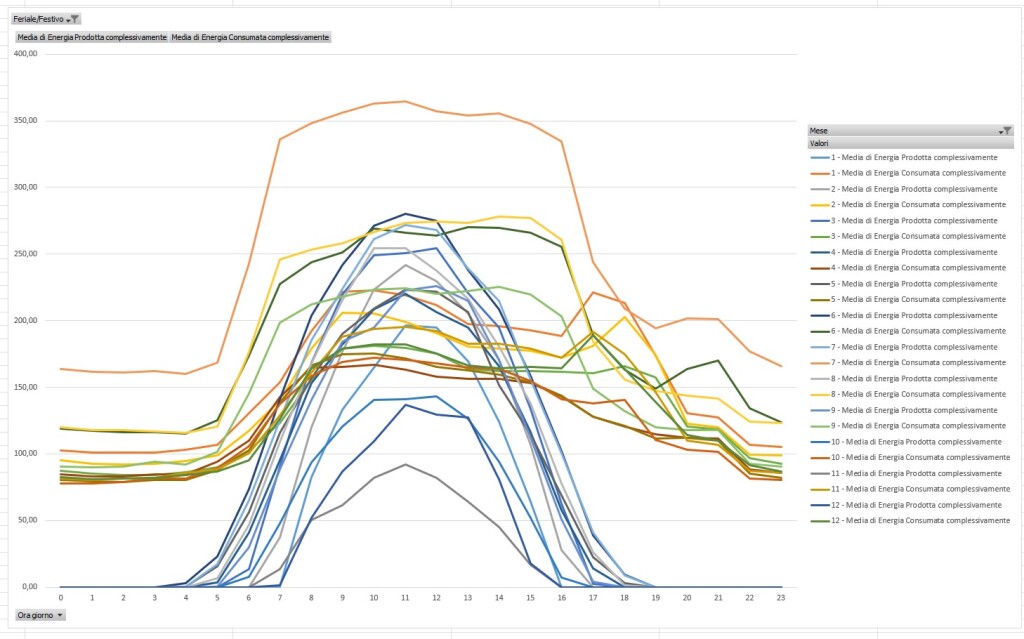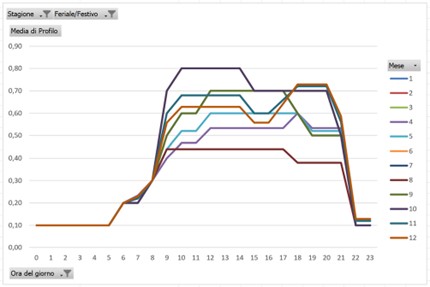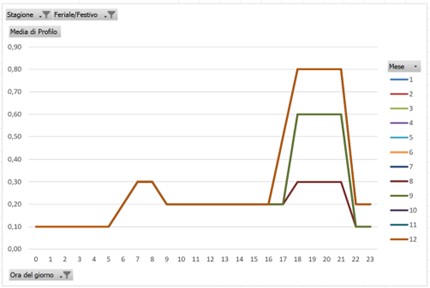AUTHOR: Alessandro Malvezzi
TUTORS: Dott. Ing. Alessandro Zichi
INTERNSHIP: —
MASTER: Master in “Sustainability and energy management in construction works” a.a 2020/21
L’Italia si trova a dover fronteggiare numerose sfide legate al post emergenza sanitaria Covid-19, alla crisi economica, alla disoccupazione, al rilancio della competitività e alla crisi energetica in atto a causa del conflitto tra Russia e Ucraina.
Figura 1: Ricostruzione del profilo orario di una fornitura elettrica domestica nei giorni festivi e feriali
La comunità europea ha messo a disposizione ingenti somme a valere sui fondi Next Generation EU per totale degli investimenti in Italia di 222,1 miliardi di euro. Una parte cospicua di questi investimenti, come previsto nel PNRR, saranno messe a disposizione della rivoluzione verde e della transizione ecologica (rigenerazione urbana per città intelligenti e sostenibili e nuove modalità di autoproduzione e autoconsumo collettivo).
Per attuare una politica sostenibile è opportuno scindere le città in comunità così da rendere più semplice la misurazione degli indicatori e il benchmark.
LEED for Communities è il principale sistema di ranking della sostenibilità ambientale, adotta un approccio olistico e multi-stakeholder, permette di innescare cambiamenti culturali, materiali ed immateriali, basati sul risparmio energetico e l’efficienza dei consumi.
La tesi analizza e propone dei crediti innovativi per l’energia elettrica condivisa nelle comunità energetiche rinnovabili e nei gruppi di autoconsumatori, previste dalla Direttiva Europea RED II 2018/2001/UE, all’interno del protocollo LEED Communities 4.1 Existing 2021.
Il presente lavoro esamina il protocollo LEED Communities rispetto agli obiettivi fissati dall’Agenda 2030, approfondisce la categorie “Energy and greenhouse gas emissions” e “Innovation” del protocollo per valorizzare l’implementazione delle nuove forme di condivisione dell’energia elettrica e, infine, illustra l’intervento di Porta Nuova a Milano proponendo delle soluzioni per sfruttare la fonte solare per la produzione di energia elettrica con l’obiettivo di ottenere un punteggio superiore nell’iter di certificazione.
Partendo dall’assioma che cottraddistingue l’autoconsumo cioè che l’energia condivisa all’interno della comunità è pari al minimo, in ciascun periodo orario, tra l’energia elettrica prodotta e immessa in rete dagli impianti della comunità e l’energia elettrica prelevata dall’insieme dei membri associati, la ricerca della configurazione ottimale tra qualità e quantità di utenze di consumo e di sistemi di produzione di energia elettrica da fonte rinnovabile, si deve basare sul monitoraggio dei profili orari di consumo e sulla composizione equilibrata di un insieme di soggetti diversi tra loro complementari nelle modalità di utilizzo dell’energia.
Su questa base sono stati implementati in excel degli strumenti di simulazione del profilo elettrico di consumo e di simulazione del funzionamento energetico di una comunità energetica rinnovabile o di un gruppo di autoconsumatori che agiscono collettivamente, determinanti per la dimostrazione del funzionamento di questa nuova forma virtuale di condivisione dell’energia elettrica a USGBC e GBCI. Tali strumenti potrebbero essere un valido ausilio per COIMA o per gli altri soggetti coinvolti nell’iniziativa per la dimostrazione e l’ottenimento dei crediti innovativi nella comunità di Porta Nuova a Milano in corso di certificazione LEED Communities 4.1.
Il primo strumento creato restituisce i profili orari delle forniture elettriche tramite la caratterizzazione dei consumi nei giorni tipo (feriale, sabato e festivo) e nei periodi dell’anno (estate e inverno) mentre il modello generato viene validato tramite il confronto con i prelievi mensili (monorari, biorari e a fasce di consumo) delle utenze elettriche recuperati dalle fatture del fornitore di energia elettrica.
A partire da questo primo strumento viene simulata la nascita di una comunità energetica rinnovabile all’interno di Porta Nuova, individuando un mix di consumo elettrico composto da utenze domestiche, uffici e attività commerciali sottese alla solita cabina secondaria. All’interno della comunità vengono analizzati i bilanci energetici dei prosumer, dei produttori e dei consumatori appartenenti alla configurazione andando a quantificare, per ciascuna ora dell’anno, l’energia autoconsumata, l’energia immessa in rete e l’energia condivisa. I risultati della simulazione mostrano come questa nuova forma di condivisione dell’energia elettrica rinnovabile permetta di vaolrizzare l’autoconsumo all’interno della comunità.
Analogamente è stata effettuata una simulazione per un gruppo di autoconsumo che agisce collettivamente (condominio) e le analisi condotte hanno evidenziato come nel caso in esame la massima produzione fotovoltaica avvenga durante periodi di bassa richiesta energetica da parte delle utenze domestiche. La simulazione ha messo in evidenza le opportunità che potrebbero essere generate con un sistema di accumulo opportunamente dimensionato in modo da immagazzinare l’energia elettrica prodotta nelle ore centrali dei giorni feriali per poi utilizzarla nelle ore serali così da incrementare la percentuale di energia condivisa sulla complessiva consumata.
In conclusione, la condivisione dell’energia elettrica prodotta favorisce l’efficienza energetica (l’avvicinamento tra il punto di produzione e il punto di consumo riduce le perdite di rete) e promuove al contempo l’utilizzo di fonti rinnovabili. A livello sociale tutto questo si traduce in un accesso più democratico alle risorse energetiche da parte dei singoli individui e rappresenta anche una prospettiva di indipendenza energetica.
FOR INTERNATIONAL STUDENTS:
Italy is facing numerous challenges related to the post-health emergency Covid-19, the economic crisis, unemployment, the relaunch of competitiveness and the energy crisis underway due to the conflict between Russia and Ukraine.
The European community has made available large sums from the EU Next Generation funds for a total investment in Italy of 222.1 billion euros. A large part of these investments, as foreseen in the PNRR, will be made available to the green revolution and the ecological transition (urban regeneration programs for smart and sustainable cities and for the diffusion of new methods of self-production and collective self-consumption).
To implement a sustainable policy, cities should be divided into communities so as to make it easier to measure the indicators and benchmark.
LEED for Communities is the main ranking system of environmental sustainability, it adopts a holistic and multi-stakeholder approach, it allows to trigger cultural changes, both material and intangible, based on energy saving and consumption efficiency.
The thesis analyzes and proposes innovative credits for shared electricity in renewable energy communities and groups of self-consumers, introduced by the European Directive RED II 2018/2001 / EU, within the LEED Communities 4.1 Existing 2021 protocol.
This work examines the LEED Communities protocol respect to the objectives set by the 2030 Agenda, examines the “Energy and greenhouse gas emissions” and “Innovation” categories of the protocol to enhance the implementation of new forms of sharing electricity and, finally, illustrates the intervention of Porta Nuova in Milan proposing solutions to exploit the solar source for the production of electricity with the aim of obtaining more points in the certification process.
Starting from the axiom that cottradistinguishes self-consumption, that the energy shared within the community is equal to the minimum, in each hourly period, between the electricity produced and fed into the grid by the community plants and the electricity withdrawn, from the set of associated members, the search for the optimal configuration between quality and quantity of consumption users and systems for producing electricity from renewable sources, must be based on the monitoring of hourly consumption profiles and on the balanced composition of a set of different subjects complementary to each other in the ways of using energy.
On this basis, tools have been implemented in excel to simulate the electrical consumption profile and simulate the energy functioning of a renewable energy community or a group of self-consumers who act collectively, decisive for the demonstration of the functioning of this new virtual form of electricity sharing to USGBC and GBCI.
These tools could be a valuable aid for COIMA or for other parties involved in the initiative for demonstrating and obtaining innovative credits in the Porta Nuova community in Milan undergoing LEED Communities 4.1 certification.
The first tool created returns the hourly profiles of electricity supplies through the characterization of consumption on typical days (weekdays, Saturdays and holidays) and in periods of the year (summer and winter) while the generated model is validated by comparing it with monthly withdrawals (single-rate, dual-rate and consumption bands) of electricity utilities recovered from the invoices of the electricity supplier.
Starting from this first tool, the birth of a renewable energy community within Porta Nuova is simulated, identifying a mix of electricity consumption consisting of domestic users, offices and commercial activities underlying the same secondary cabin. Within the community, the energy balances of the prosumers, producers and consumers belonging to the configuration are analyzed, quantifying, for each hour of the year, the self-consumed energy, the energy fed into the grid and the shared energy. The results of the simulation show how this new form of sharing renewable electricity makes it possible to enhance self-consumption within the community.
Similarly, a simulation was carried out for a self-consumption group acting collectively (condominium) and the analyzes carried out showed that in the case in question, the maximum photovoltaic production occurs during periods of low energy demand by domestic users.
The simulation highlighted the opportunities that could be generated with an appropriately sized storage system in order to store the electricity produced in the central hours of the weekdays and then use it in the evening so as to increase the percentage of shared energy on the worn out overall.
In conclusion, the sharing of the electricity produced favors energy efficiency (the approach between the point of production and the point of consumption reduces grid losses) and at the same time promotes the use of renewable sources. On a social level, all this translates into a more democratic access to energy resources by individuals and also represents a perspective of energy independence.



